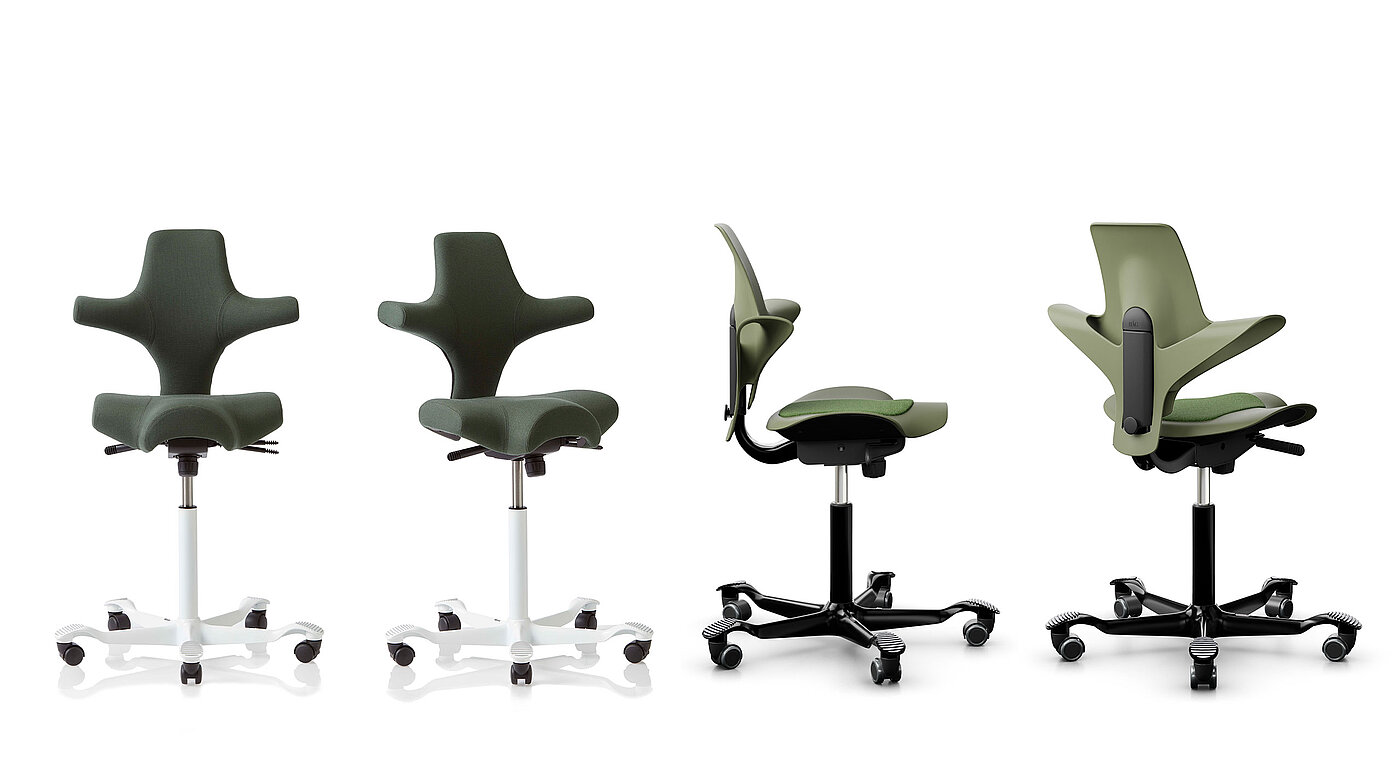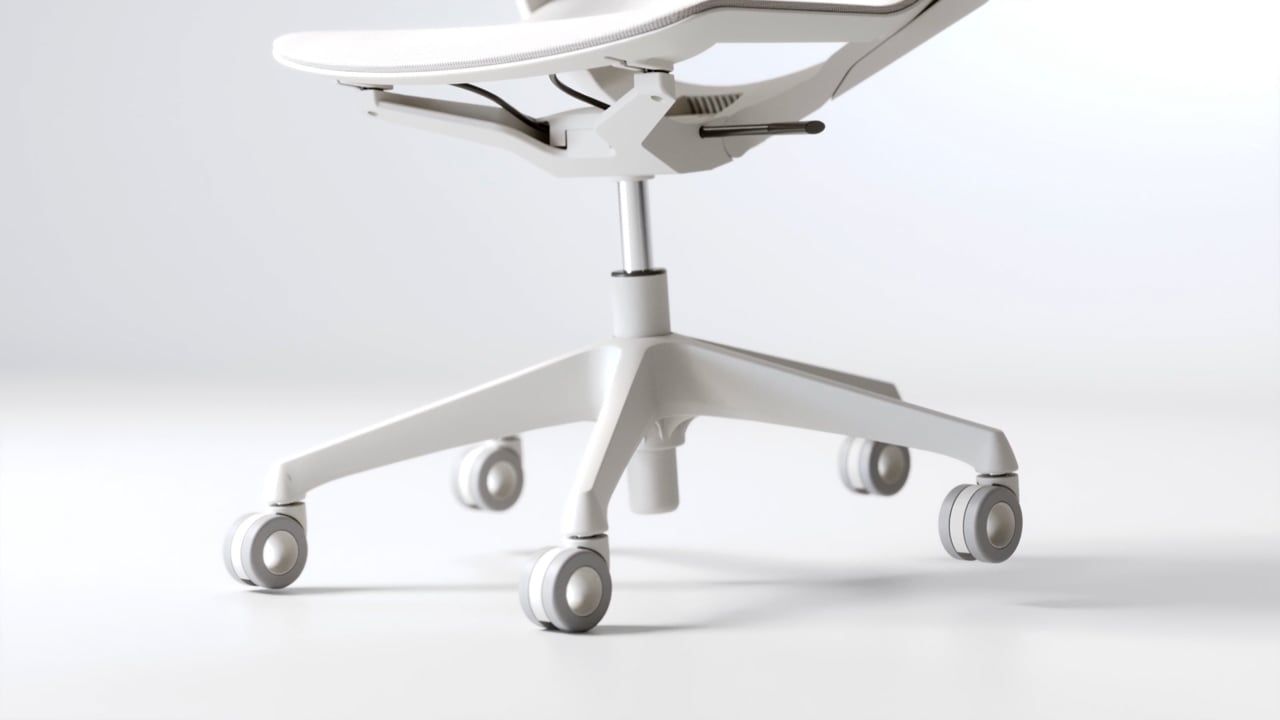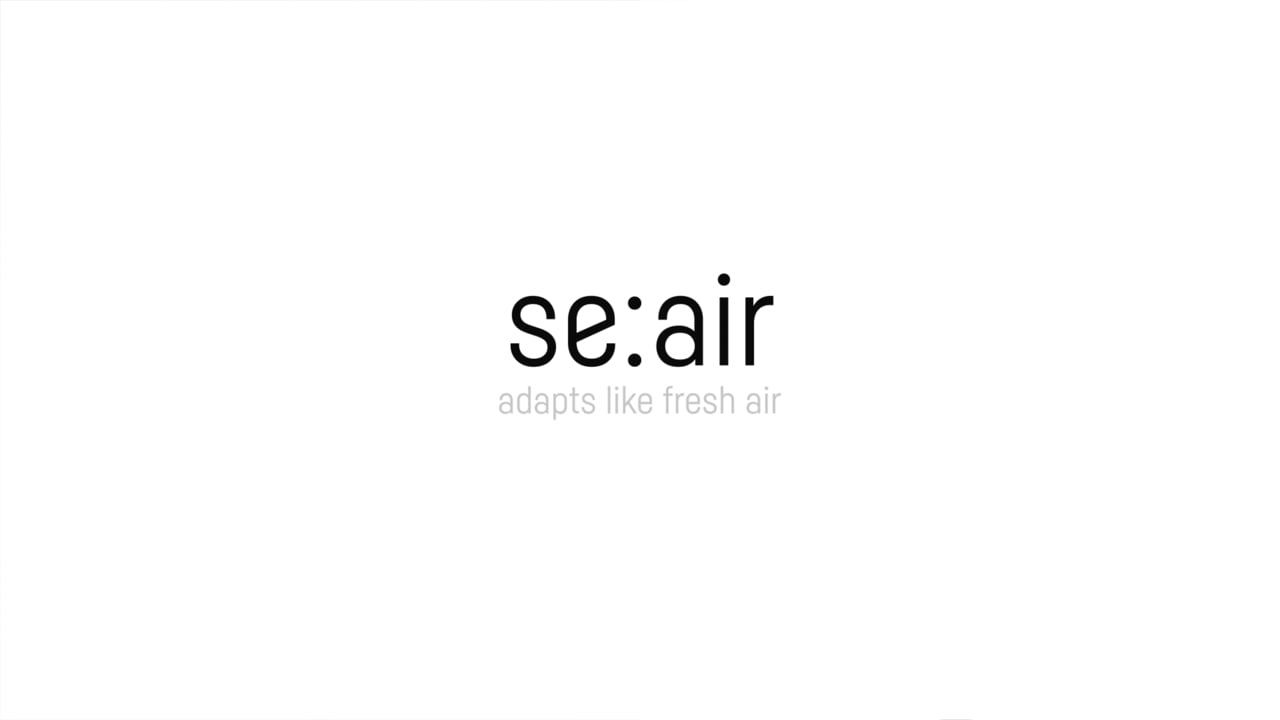![[Translate to English:] [Translate to English:]](/fileadmin/_processed_/8/2/csm_20220923_Iconic_Chairs_Header_Image_Tonon_Fl%40t_Black_Wall_01_f2b907011c.jpg)
Iconic Chairs - seating classics of past and future

Used every day and proving their quality over the years, office chairs are not only a reflection of the developments in design, technology and materials their sector has experienced, they are also a reflection of social and cultural changes in working and office life, as they invariably give us an insight into how we live and work.
As part of the Iconic Series, Red Dot takes a look at the transformation of the office chair and at how changes in working conditions and professions are reflected by these design pieces.
Aluminium Chair EA 119, 1958
Manufacturer: Vitra, Switzerland
Design: Charles & Ray Eames
The EA 119 office chair from 1958 is one of the most celebrated and significant designs of the 20th century. Charles and Ray Eames broke new ground with the construction of this chair. Instead of using the familiar seat shell made of plywood or plastic, they tautly stretched an elastic fabric or leather panel between two lateral aluminium side ribs. These gave the chair its shape and stability, but also made it very comfortable without the need for elaborate upholstery.
With the EA 119, Charles and Ray Eames introduced aluminium casting, infinite adjustment of the seat height with the help of a pneumatic spring as well as an adjustable tilt mechanism and castors for the five- star base. Their successful design showed how modern technology and high-quality materials could be combined through intelligent design, and how new quality standards for office chairs could be achieved with the help of industrial production.
Oxford Chair, 1965
Manufacturer: Fritz Hansen, Denmark
Design: Arne Jacobsen
The Oxford chair, which was launched by furniture manufacturer Fritz Hansen in 1965, is a further development of the elegant high-backed chair that Arne Jacobsen designed for the dining hall at St. Catherine’s College in 1962.
The precursor for the high-backed Oxford chair was made in a single plywood shell shaped to match the curvature of the human back. The chair has been dubbed the Professor chair because it was used at the high table in the dining hall, reserved for the fellows of the college. The Oxford chair represents authority and prestige.
Supporto Chair, 1976
Manufacturer: Zoeftig, Great Britain
Design: Frederick Scott
In 1976, British designer Frederick Scott created "Supporto Chair", an iconic office chair whose polished aluminium embodied the prestige of an executive chair. Although the chair communicates quality and status, the simplicity and cleanness of the design are pleasingly understated.
As early as the 1970s, the ergonomic design and the durable materials from which the chair is made satisfied the desire to adapt the workplace to people’s needs and not the other way round. The cruciform base and armrests are made of polished die-cast aluminium, the cover from black leather, while the height and tilt of the seat and backrest can be adjusted pneumatically. The winning combination of prestige and aesthetics, materials and form make the “Supporto Chair” a role model for other office chairs.
Silver, 2003
Manufacturer: Interstuhl, Germany
Design: Hadi Teherani
The office chair Silver, designed in 2003 by architect Hadi Teherani, owes its unmistakable appearance to its high-quality aluminium construction. It conveys quality and exclusivity while the Intricate construction results in a winningly simple operation and the sophisticated artistry of the engineering is concealed. A synchronous mechanism coordinates the backward movement of the backrest with a corresponding tilt of the seat. The body is thus ideally supported in every position.
High-grade materials also define the haptics of the Silver chair, whereas the technology remains invisible as operating elements are perfectly integrated into the overall form. The chair’s futuristic design has multiple times made it a secret TV and movie star, whether alongside James Bond in “Quantum of Solace” in 2008 or in a wide range of TV studios. The iconic shape of this office chair is a successful combination of prestige, performance and aesthetics.
In the 1970s and 1980s, when office work was on the rise, ergonomics greatly influenced the development of office chairs. Designers such as Niels Diffrient, Donald Chadwick and Peter Opsvik became the pioneers of ergonomically designed office chairs. Their endeavour to improve people’s living and working environments led to innovative creations that changed the design of office chairs and the industry as a whole.
With the Aeron office chair, the desire for ergonomically designed chairs in the 1990s grew to such an extent that the topic of “ergonomics” became mainstream in the organisation of work and offices. Eventually, people no longer had to leave their desks to access files or documents. With computer technology becoming widely available in offices, people got used to spending up to eight hours at their desk.
Aeron, 1994
Manufacturer: Herman Miller, USA
Design: Bill Stumpf and Don Chadwick
The launch of the Aeron office chair by Herman Miller in 1994 was the start of a new chapter in the design of ergonomic office chairs. Since its introduction 30 years ago, it has stood for design innovation and sustainability.
Years of research and work by Bill Stumpf and Don Chadwick went into studying how people sit and are the reason why they produced nothing less than an ergonomic revolution. Their best known, jointly developed product, the Aeron office chair, was pioneering for its ergonomic design and use of breathable pellicle material. It flexes in various directions and improves weight distribution, that the chair can do without additional upholstery or foam, textile or leather covers.
Since its commercial launch 30 years ago, it has not only become one of the bestsellers in office chairs but has also had a lasting influence on the sector. Today, the Aeron is made with more than 50 per cent recycled materials and, since 2021, also with ocean-bound plastic. A black Aeron Gaming Edition is today hugely popular with young gamers thanks to the well-engineered comfort that it offers over many hours of use.
open up, 2000
Manufacturer: Sedus Stoll, Germany
Design: Mathias Seiler
In the year 2000, Sedus offered users the best of both worlds with the introduction of the open up: high-quality materials and the polished aluminium base on the one hand, and ergonomic seating and relaxation on the other.
A distinctive feature of the open up office swivel chair is the exceptional reclining angle of the backrest, which can tilt up to 45 degrees. An angle not achieved by any other office chair on the market. The chair owes its freedom of movement to a dorsokinetically suspended backrest which provides optimal support for the body – both for the sides and the back.
The backrest follows all rotating and lateral movements of the body while height-adjustable lumbar support relieves strain on the lower spine. “Freedom of movement releases the mind,” says the manufacturer Sedus Stoll. Simply lean back and relax, switch off and free up your thoughts.
SITAGWAVE, 2009
Manufacturer: SITAG, Switzerland
Design: Uli Witzig & Ergonamics
“In its essence, the human body was and is movement. In their essence, office chairs were and are static.” That is how Swiss designer Uli Witzig describes the dilemma of occupational protracted sitting and that is what made the job of developing an office chair with a design scrupulously guided by human use so appealing to him.
In 2009, the Swiss company SITAG launched SITAGWAVE, an office swivel chair designed by Uli Witzig, whose formal construction of the backrest not only recalls the shape of the human skeleton, but also supports and relieves pressure on it to allow for “dynamic sitting”. Both the backrest and the seat adapt to the body of the user and are designed to support the back and pelvic muscles.
The elasticity of the backrest absorbs the pressure of the body and adapts to the rotations of the back and upper body while the flexible mounting of the seat reacts to every movement the user makes – quite independently without the need for complicated adjustments. The chair adapts to humans, not the other way round.
HÅG Capisco Puls, 2011
Manufacturer: Flokk, Norway
Design: Peter Opsvik


The concept of “dynamic sitting” or the idea of sitting as an “active occupation” also define the distinctive design of the HÅG Capisco Puls. Peter Opsvik’s contribution to the development and design of chairs that prompt users to adopt different positions multiple times when they are sitting goes as far back as the late 1970s. When the HÅG Capisco was launched in 1984, it was the incarnation of all of Opsvik’s ideas relating to freedom of movement and changes in posture.
“Humans were created for life on the move,” Peter Opsvik said in the year that the HÅG Capisco came onto the market, “and then they suddenly had to switch to a passive existence where they had to spend as much as 80% to 90% of their waking hours sitting.” The solution is a chair that prompts users to be active while seated. With its unmistakeable “saddle seat”, inspired by the flexible posture adopted by horse riders, the HÅG Capisco has become a design icon and set new standards.
Like its predecessor, the HÅG Capisco Puls from 2011 also epitomises Peter Opsvik’s understanding of design. Whether users are sitting, half-standing, sitting sideways or backwards, the chair supports them and encourages them to adopt different positions.
The shape, inspired by the form of a saddle, is likewise an expression of a change in perception of work and office organisation and is not only valued by the creative professions but also by laboratories and clinics. A chair that was ahead of its time and is thus still perfectly in tune with today’s needs.
IN, 2015
Manufacturer: Wilkhahn, Germany
Design: wiege Entwicklungsgesellschaft
“IN teaches seating to walk”, says the manufacturer Wilkhahn about the office chair with patented Trimension® kinematics. Even the smallest shifts in weight lead to fluid changes in posture that are perceived as highly natural and comfortable. The interaction between user and chair is completely intuitive, making mobility a frequently used and versatile characteristic of use.
Perfectly synchronized 3D dynamics combined with exceptional comfort stimulate the body, increase concentration and make work a relaxing experience.
ing, 2019
Manufacturer: KOKUYO, Japan
Design: Kazuo Oku, Takayoshi Kano, Yojiro Kinoshita, Kenta Asano
The human body with its numerous muscles and joints is designed to move as much as possible. The “ing” office chair meets this need with the concept of “free from sitting”.
Using a sophisticated mechanism, the seat can “glide” around in a 360-degree radius to follow any movement of the user’s body. This construction principle helps the muscles in the user’s hip, waist and back remain active when sitting. At the same time, the pressure on the body is thus also distributed, reducing the overall load and strain.
In addition, the “ing” office chair impresses with a well-balanced look and high-quality finish, merging all the elements into a unity of almost flowing appearance.
Viewed not only as objects but in the context of their time, the different office chairs are a visual chronicle of a transformation in values, stretching from perceptions of prestige and ergonomics to the current way of working in multidisciplinary teams.
If you have your own office chair, you can adjust it to your own personal preferences. But in most of the spaces we use for work, we do not have a dedicated office chair. The availability of Wi-Fi, better mobile networks and the advent of mobile devices mean many of us are no longer tied to a fixed place of work. Quite a few people today work in project spaces or conference rooms as well as from changing workplaces or open-plan offices. A chair with a large number of individual settings is not suitable for these scenarios. Digitalisation and the new forms of work it entails require a new generation of office chairs.
Setu, 2010
Manufacturer: Herman Miller, USA
Design: Studio 7.5
Those who have their own office chair can adapt it to their needs. However, new forms of work require office chairs that adapt to different users.
With Setu, the Berlin-based Studio 7.5 designed a chair for Herman Miller that would adapt to changing work environments with a construction that was as simple as possible. The challenge was to develop a part that would unite backrest and seat in a single continuous element. After numerous drafts and prototypes, the designers created a flexible bracket, the Kinematic Spine. It controls resistance when users lean back, supports the body and constitutes the spine of the chair on both sides of the backrest. In combination with an elastic fabric, which is also part of the construction, the Kinematic Spine gives the office chair its characteristic contours.
In the past, the seat and backrest of a kinematic chair were separate and had to be connected with the help of a hinge that reacted to the weight of the user. With Setu, the weight of the user controls the bending strength of the kinematic element. That makes it flexible in use for different users and work scenarios. The only adjustment that is required is the seat height.
Camiro work&meet, 2015
Manufacturer: Girsberger, Switzerland
Design: Design Ballendat
The Camiro work&meet was designed specifically for conferences and also as an alternative for desk settings when an easy-to-adjust swivel chair is called for. It features only two adjustment functions: seat height and backrest lock. In terms of form, the seat appears to float on its aluminium supports.
Despite its thin seat cushioning, this swivel chair is very comfortable as it features an internal, stretched-mesh suspension and a tilt function that allows movement while seated.
Cosm, 2019
Manufacturer: Herman Miller, USA
Design: Studio 7.5
Cosm is the result of the logical progression of the Setu and Mirra 2 office chairs, designed by Berlin-based Studio 7.5 for Herman Miller. Just like its predecessor Setu, the Cosm office chair has a continuous membrane seat and, like Mirra 2, a central bracket as a supporting element to stabilise the backrest. “What makes the chair remarkable, however, is that Cosm is fully self-adjusting,” Burkhard Schmitz from Studio 7.5 says.
In an interview with Red Dot, the Berlin-based design studio explains the concept behind the chair. “Our idea was to offer users an experience – the experience of weightlessness. That is why the project was codenamed ‘Flying Carpet’. The concept was one of floating in the air, so that you can focus on the task at hand and forget about gravity.”
Cosm requires no manual adjustment. It does that automatically when the user sits on the chair. To provide users with the highest level of comfort, Studio 7.5 developed Cosm’s Leaf Arms. A supple yet at the same time sturdy frame offers wide, comfortable support for the elbows. The angle of the armrests ensures that chair and desk do not get in each other’s way and users can comfortably hold a book or smartphone.
The sculptural shape and weightless aesthetic of Cosm are not only underscored by its material and ergonomic quality, but also by its monochrome colouring. From top to bottom, it has the same colour, which can be tailored to any ambience or interior.
There are phases where an industry proves itself on the strength of innovative solutions which no one had anticipated or expected. And there are times when an industry has to prove itself because external conditions dictate it.
The sustainability of products, the responsible use of resources and the COVID-19 pandemic are also reflected in the design of office chairs. Recyclable and sustainable materials of the future are also shaping the current designs of designers and companies. Times are changing once again.
Cynara, 2021
Manufacturer: Okamura, Japan
Design: Ing-B (Joachim Brüske), B4K (Andreas Krob)
The construction of the Cynara office chair is inspired by the performance of the “Yumi”, a Japanese longbow, which draws power and dynamic from its distinctive arc form. This led to a functional, ergonomically designed lightweight chair with a continuous mesh surface between the seat and back.
"Cynara can be a task chair, a conference chair or a side chair – in the office or at home," says Andreas Krob. „In architecture, the task chair is no longer related to a specific personal workspace in the future. The chair must be lightweight, flexible and ergonomic.”
Okamura made the design idea a reality, with less weight, thereby reducing CO2 emissions through production and logistics. CYNARA is a functional and aesthetically pleasing task chair for different uses, with deep consideration given to ergonomics and sustainability.

se:air, 2023
Manufacturer: Sedus, Germany
Design: Konstantin Thomas

The more hybrid, agile and individual the work becomes, the more dynamic and uncomplicated the office swivel chair needs to be – no matter where the work is done. In open spaces, in individual offices and in the home office, light and filigree design is more in demand than ever.
se:air has an air-permeable mesh membrane in the seat and backrest, thus ensuring breathable comfort. The patented “Kinetic Swing” mechanism automatically detects the user’s weight without them having to think about it or adjust anything themselves. The higher the user's weight, the greater the resistance when leaning against the backrest
As early as in the design process, efforts were made to reduce the individual components and to leave out what was redundant. This results in a light, total weight of only 12 kg and a recyclability of 100%.
se:air is available in five different colour versions and follows a monochromatic colour concept. The frame, membrane, armrests and castors are all designed in the same colour.
Calma, 2023
Manufacturer: Andreu World, Spain
Design: Layer, Benjamin Hubert
Since the pandemic in particular, the boundaries between office and home working have become ever more fluid. It is therefore no coincidence that it was precisely during this period that the idea for Calma was born: an ergonomic, elegantly proportioned desk chair that combines the comfort and aesthetics of home with the need for a functional yet inspiring work environment.
The hallmark of the Calma collection is a die-cast aluminium frame that wraps around the backrest and merges seamlessly with the loop-shaped armrests. The result is a clean, flowing shape that, together with the sophisticated mix of materials ranging from metal to textiles, creates a soothing and tranquil work atmosphere.
Calma is made from recycled aluminium and reusable plastics and is thought for the Cradle to Cradle. The result is an enduring, timeless designer piece that can be taken apart at the end of its service life and either repaired or recycled.